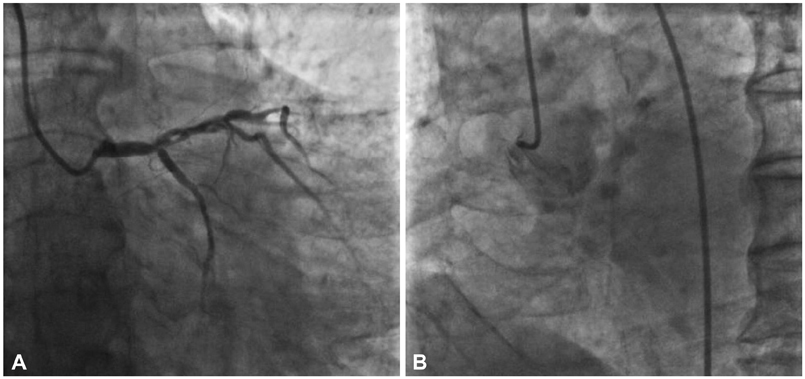Korean Circ J.
2014 Mar;44(2):113-117. 10.4070/kcj.2014.44.2.113.
Unprotected Left Main Percutaneous Coronary Intervention in a 108-Year-Old Patient
- Affiliations
-
- 1Department of Cardiology, National Institute of Cardiovascular Diseases, Dhaka, Bangladesh. drmonwarbd@yahoo.com
- KMID: 2223900
- DOI: http://doi.org/10.4070/kcj.2014.44.2.113
Abstract
- With the increase in life expectancy, the proportion of very elderly people is increasing. Coronary artery disease (CAD) is an important cause of mortality and morbidity in this age group, for which myocardial revascularization is often indicated. Percutaneous coronary intervention (PCI) in the very elderly bears the inherent risks of complications and mortality, but the potential benefits may outweigh these risks. A number of observational studies, registries, and few randomized controlled trials have shown the safety and feasibility of PCI in octogenarians and nonagenarians. However, PCI is only rarely done in centenarians; so, the outcome of percutaneous coronary revascularization in this age group is largely unknown. PCI in a centenarian with complex CAD is described here; the patient presented with unstable angina despite optimum medical therapy, and surgery was declined. Good angiographic success was followed by non-cardiac complications, which were managed with a multidisciplinary approach.
MeSH Terms
Figure
Reference
-
1. Office for National Statistics. Statistical bulletin: Estimates of the Very Old (including Centenarians), 2002-2011, England and Wales [Internet]. Accessed on July 23, 2013. Available from: http://www.ons.gov.uk/ons/dcp171778_303741.pdf.2. United State's Census Bureau. The 2012 Statistical Abstract; Population: Estimates and Projections by Age, Sex, Race/Ethnicity; Resident Population Projections by Race, Hispanic Origin Status, and Age--Projections [Internet]. Accessed on July 23, 2013. Available from: http://www.census.gov/compendia/statab/2012/tables/12s0012.pdf.3. Gale CP, Cattle BA, Woolston A, et al. Resolving inequalities in care? Reduced mortality in the elderly after acute coronary syndromes. The Myocardial Ischaemia National Audit Project 2003-2010. Eur Heart J. 2012; 33:630–639.4. Singh M, Peterson ED, Roe MT, et al. Trends in the association between age and in-hospital mortality after percutaneous coronary intervention: National Cardiovascular Data Registry experience. Circ Cardiovasc Interv. 2009; 2:20–26.5. Bauer T, Möllmann H, Weidinger F, et al. Predictors of hospital mortality in the elderly undergoing percutaneous coronary intervention for acute coronary syndromes and stable angina. Int J Cardiol. 2011; 151:164–169.6. Wang TY, Gutierrez A, Peterson ED. Percutaneous coronary intervention in the elderly. Nat Rev Cardiol. 2011; 8:79–90.7. McKellar SH, Brown ML, Frye RL, Schaff HV, Sundt TM 3rd. Comparison of coronary revascularization procedures in octogenarians: a systematic review and meta-analysis. Nat Clin Pract Cardiovasc Med. 2008; 5:738–746.8. Rana O, Moran R, O'Kane P, et al. Percutaneous coronary intervention in the very elderly (≥85 years): trends and outcomes. Br J Cardiol. 2013; 20:27–31.9. Rathod K, Knight C. Percutaneous coronary intervention in old age-effective or intrusive? Br J Cardiol. 2013; 20:6–7.10. King SB 3rd, Marshall JJ, Tummala PE. Revascularization for coronary artery disease: stents versus bypass surgery. Annu Rev Med. 2010; 61:199–213.11. Sheridan BC, Stearns SC, Rossi JS, D'Arcy LP, Federspiel JJ, Carey TS. Three-year outcomes of multivessel revascularization in very elderly acute coronary syndrome patients. Ann Thorac Surg. 2010; 89:1889–1894. discussion 1894-5.12. Hlatky MA, Boothroyd DB, Bravata DM, et al. Coronary artery bypass surgery compared with percutaneous coronary interventions for multivessel disease: a collaborative analysis of individual patient data from ten randomised trials. Lancet. 2009; 373:1190–1197.13. Alam M, Virani SS, Shahzad SA, et al. Comparison by meta-analysis of percutaneous coronary intervention versus coronary artery bypass grafting in patients with a mean age of ≥70 years. Am J Cardiol. 2013; 112:615–622.14. Kaehler J, Meinertz T, Hamm CW. Coronary interventions in the elderly. Heart. 2006; 92:1167–1171.15. Fajadet J, Chieffo A. Current management of left main coronary artery disease. Eur Heart J. 2012; 33:36b–50b.16. Dash D. Stenting of left main coronary artery stenosis: A to Z. Heart Asia. 2013; 5:18–27.17. Capodanno D, Stone GW, Morice MC, Bass TA, Tamburino C. Percutaneous coronary intervention versus coronary artery bypass graft surgery in left main coronary artery disease: a meta-analysis of randomized clinical data. J Am Coll Cardiol. 2011; 58:1426–1432.18. Mohr FW, Morice MC, Kappetein AP, et al. Coronary artery bypass graft surgery versus percutaneous coronary intervention in patients with three-vessel disease and left main coronary disease: 5-year follow-up of the randomised, clinical SYNTAX trial. Lancet. 2013; 381:629–638.19. Groeneveld PW, Matta MA, Greenhut AP, Yang F. Drug-eluting compared with bare-metal coronary stents among elderly patients. J Am Coll Cardiol. 2008; 51:2017–2024.20. Douglas PS, Brennan JM, Anstrom KJ, et al. Clinical effectiveness of coronary stents in elderly persons: results from 262,700 Medicare patients in the American College of Cardiology-National Cardiovascular Data Registry. J Am Coll Cardiol. 2009; 53:1629–1641.
- Full Text Links
- Actions
-
Cited
- CITED
-
- Close
- Share
- Similar articles
-
- Intravascular Ultrasound-Guided Percutaneous Coronary Intervention with Drug-eluting Stent for Unprotected Left Main Disease via Left Snuffbox Approach
- Current Status and Future Perspective of Left Main Coronary Intervention
- Stenting of Unprotected Left Main Coronary Artery Stenosis without Anticogulation: Immediate and Late Outcomes
- A Case of Left Coronary Artery Milking Treated by Direct Stenting During Percutaneous Coronary Intervention in A Patient with Unstable Angina
- Left main artery stenting under percutaneous cardiopulmonary support after right coronary artery ST elevation infarction




